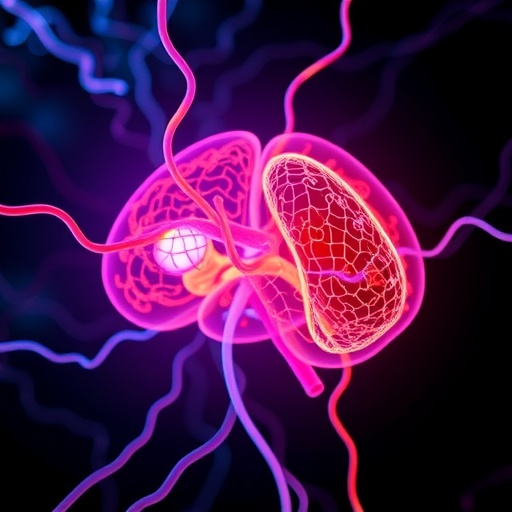In a groundbreaking advancement poised to reshape the landscape of psychiatric treatment, researchers have unveiled novel ketamine derivatives that promise enhanced antidepressant effects through a previously underappreciated mechanism involving adenosine signaling in the brain. This pioneering study, recently published in Nature, leverages a phenotypic drug discovery approach centered on modulating extracellular adenosine levels in the medial prefrontal cortex (mPFC), a critical brain region implicated in mood regulation and depression.
The research team synthesized and meticulously tested 31 ketamine-derived compounds by strategically modifying specific molecular sites: the chloro substituent on the aromatic ring, the methylamino group linked to the cyclohexanone ring, and the sixth position on the cyclohexanone ring, which serves as a primary locus for metabolic hydroxylation. This comprehensive chemical redesign aimed to pinpoint analogues that outperform ketamine, the current gold standard in rapid-acting antidepressant treatment, by enhancing adenosine modulation.
To assess these compounds’ functional impact, the researchers employed fiber photometry—a cutting-edge technique allowing real-time monitoring of extracellular adenosine fluctuations directly within the mPFC of living mice. This innovative use of adenosine dynamics as a biomarker enabled the identification of analogues capable of triggering robust and sustained adenosine surges. Among the compounds tested, two dechlorinated derivatives, deschloroketamine (DCK) and deschloro-N-ethyl-ketamine (2C-DCK), stood out by significantly amplifying adenosine release at doses as low as 2 and 5 mg/kg, surpassing ketamine’s effects observed at 10 mg/kg doses.
Notably, the superior adenosine-modulating properties of DCK were evident even at the lowest tested dose of 2 mg/kg, marking a substantial leap in potential therapeutic efficiency. This dose responsiveness underscores the compound’s promising pharmacodynamic profile, suggesting that effective antidepressant action could be achieved with markedly diminished systemic exposure, potentially minimizing side effects.
To investigate the functional consequences of heightened adenosine release, the study utilized behavioral paradigms widely accepted in psychiatric research: the forced swim test (FST) and the sucrose preference test (SPT). These assays, performed in mice subjected to chronic restraint stress to model depression-like states, revealed that DCK exhibited robust antidepressant-like effects at doses significantly lower than those required for ketamine. Specifically, DCK administered at 2 mg/kg elicited comparable amelioration of depressive behaviors relative to 10 mg/kg ketamine, with heightened efficacy observed at 5 mg/kg.
Parallel evaluations of 2C-DCK mirrored these findings, demonstrating potent antidepressant efficacy at 5 mg/kg, while 3’-chloro-ketamine, a structurally distinct analogue that failed to evoke substantial adenosine surges, showed no behavioral improvement even at the highest doses. This clear correlation between adenosine modulation and antidepressant efficacy solidifies the role of extracellular adenosine dynamics as a predictive biomarker for therapeutic potential in novel ketamine derivatives.
Crucially, the study also addresses safety considerations by evaluating the propensity of these analogues to induce hyperlocomotion, a behavioral proxy for dissociative side effects commonly associated with ketamine. DCK, at its effective antidepressant dose of 2 mg/kg, produced only mild increases in locomotor activity, contrasting the significant hyperlocomotion induced by 10 mg/kg ketamine. This finding suggests a wider therapeutic window and a possibly improved side effect profile for DCK, enhancing its clinical appeal.
In dissecting the mechanistic underpinnings of these observations, the research investigates the relationship between N-methyl-D-aspartate receptor (NMDAR) antagonism—a well-established mode of action of ketamine—and adenosine release. By systematically comparing the in vivo adenosine-inducing capacity of ketamine and six analogues with their corresponding in vitro NMDAR inhibitory IC50 values and brain pharmacokinetic profiles, the authors discovered a striking dissociation.
Specifically, no direct correlation emerged between the degree of NMDAR blockade and adenosine surge magnitude. This was exemplified by 3’-chloro-ketamine, which potently inhibited NMDARs without triggering adenosine release, in contrast to 3C-DCK, which elicited strong adenosine responses despite comparable NMDAR affinity. These results decisively indicate that NMDAR antagonism is not the primary driver of extracellular adenosine elevation.
Supporting this interpretation, prior parts of the study demonstrated that ketamine exerts direct modulatory effects on mitochondrial metabolism, a non-NMDAR pathway, which appears to orchestrate adenosine dynamics. This novel insight pivotally shifts the focus from classical glutamatergic hypotheses toward purinergic signaling as a central mediator of ketamine’s antidepressant actions.
Overall, this study exemplifies the power of integrating chemical synthesis, advanced in vivo neurochemical monitoring, and behavioral pharmacology to unravel complex therapeutic mechanisms. By identifying adenosine signaling as both a biomarker and a mediator of antidepressant efficacy, the researchers provide a compelling rationale for developing ketamine analogues with optimized purinergic profiles, offering hope for rapid-acting antidepressants with reduced side effects.
This research not only broadens our understanding of ketamine’s multifaceted pharmacology but also charts a promising course for next-generation antidepressant drug development. As depression remains a leading cause of global disability, breakthroughs that enhance treatment efficacy while minimizing adverse effects represent a transformative step forward in psychiatric medicine.
Future exploration will undoubtedly focus on further elucidating the interplay between mitochondrial function, adenosine signaling, and neuronal circuitry in mood regulation, while advancing these ketamine analogues toward clinical trials. The prospect of efficacious, fast-acting antidepressants with safer profiles could revolutionize care for millions suffering from treatment-resistant depression worldwide.
In conclusion, the identification of deschloroketamine and its derivatives as potent modulators of adenosine dynamics heralds a new paradigm in antidepressant pharmacotherapy. By integrating phenotypic screening and mechanistic insights, this work paves the way for innovative treatments rooted in a deeper understanding of brain metabolism and purinergic neurotransmission, marking a milestone in the quest to alleviate the global burden of depression.
Subject of Research: Development of ketamine-derived compounds enhancing antidepressant effects via adenosine signaling in the medial prefrontal cortex.
Article Title: Adenosine signalling drives antidepressant actions of ketamine and ECT.
Article References:
Yue, C., Wang, N., Zhai, H. et al. Adenosine signalling drives antidepressant actions of ketamine and ECT. Nature (2025). https://doi.org/10.1038/s41586-025-09755-9




